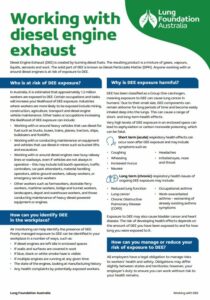Diesel Engine Exhaust (DEE) is produced by burning diesel fuels, resulting in a mixture of gases, vapours, liquids, aerosols, and soot. The solid part of DEE is known as Diesel Particulate Matter (DPM). This fact sheet is for anyone at-risk of DEE and aims to educate on the risks associated with DEE exposure; control measures that can help protect against exposure and current regulations in Australia.
Who is at Risk?
Workers at higher risk of DEE exposure include those:
- Operating heavy vehicles (trucks, buses, trains, planes, tractors, ships, bulldozers, forklifts)
- Maintaining diesel equipment in mines (bucket lifts, excavators)
- Working near busy railway lines or roadways (toll booth operators, traffic controllers, car park attendants, material handling operators, airline ground workers, railway workers, emergency service workers)
Health Risks of DEE Exposure
DEE is classified as a Group One carcinogen, meaning it can cause lung cancer. Its small components can remain airborne and be inhaled deeply into the lungs, causing both short-term and long-term health effects. Acute effects include coughing, wheezing, increased mucus, nausea, headaches, and irritated eyes, nose, and throat. Chronic exposure can lead to reduced lung function, lung cancer, COPD, occupational asthma, and heart disease.
Identifying DEE in the Workplace
Signs of poorly managed DEE exposure include:
- Diesel engines idling in enclosed spaces
- Soot-covered walls and surfaces
- Visible smoke haze (blue, black, or white)
- Multiple engines running simultaneously
- Health complaints from workers
Managing DEE Exposure
Employers must manage DEE risks by following the Hierarchy of Controls:
- Elimination: Avoid processes that generate DEE
- Substitution: Use safeter alternative i.e. electric-powered machines instead of diesel
- Isolation: Separate workers from DEE sources
- Engineering Controls: Use ventilation systems and exhaust gas treatments
- Administrative Controls: Implement training, policies, and regular maintenance
Was this page helpful?
Good job! Please give your positive feedback
How could we improve this post? Please Help us.
